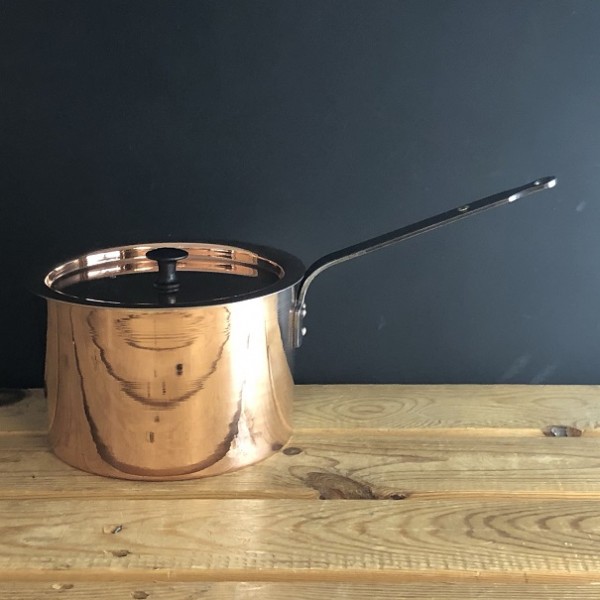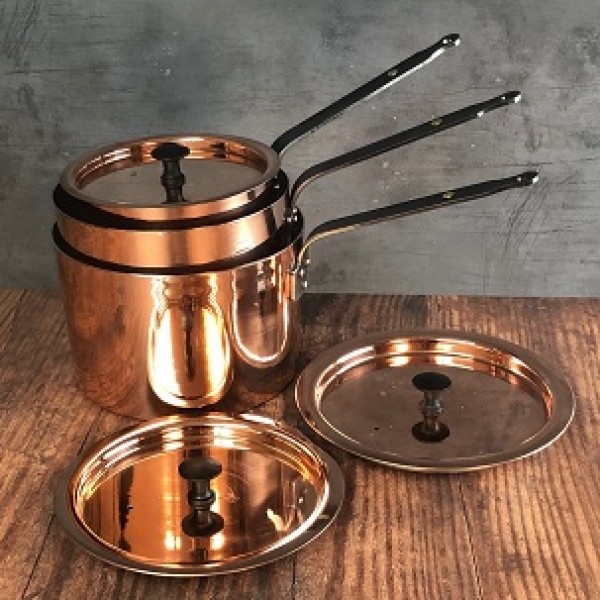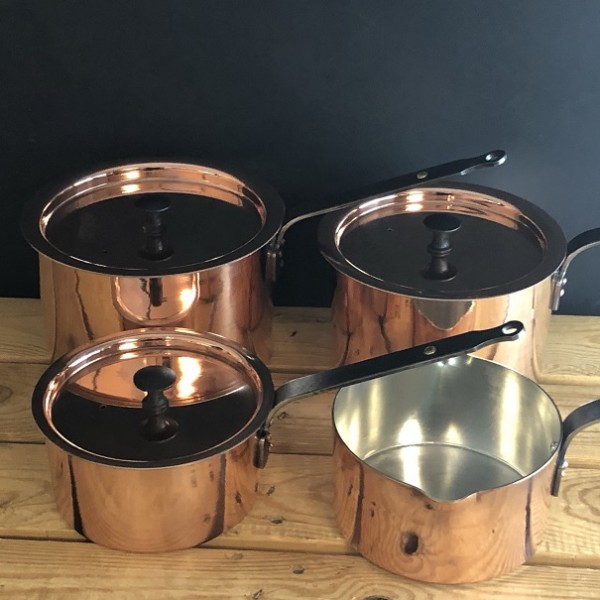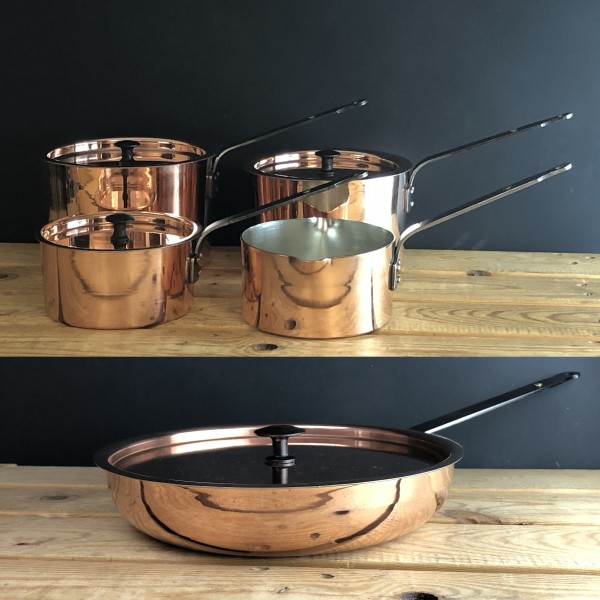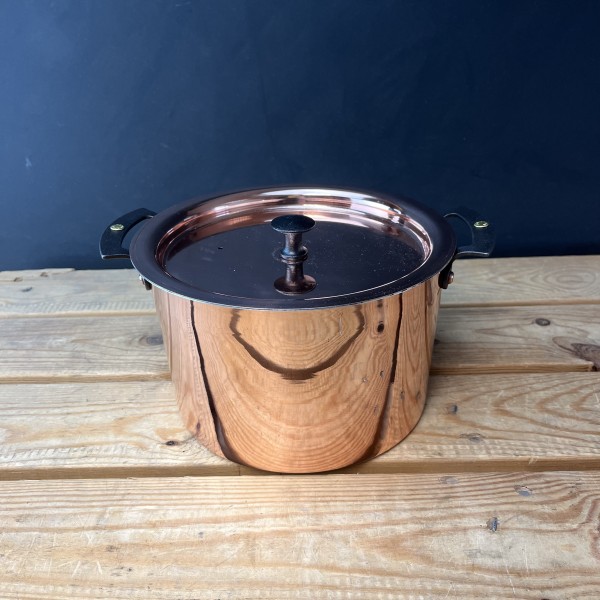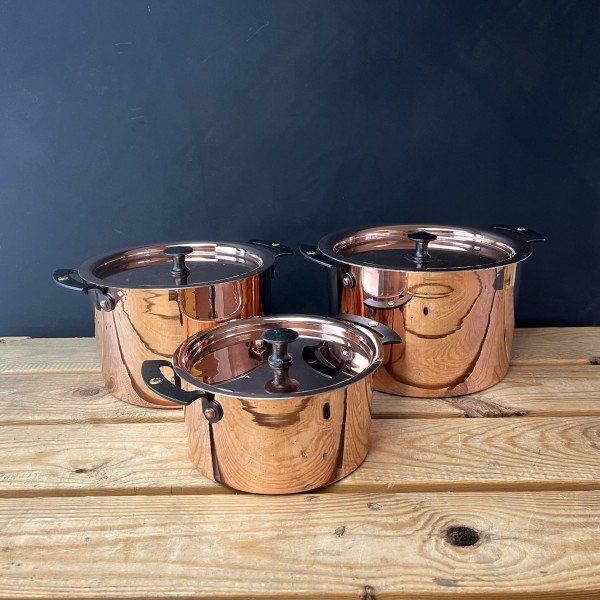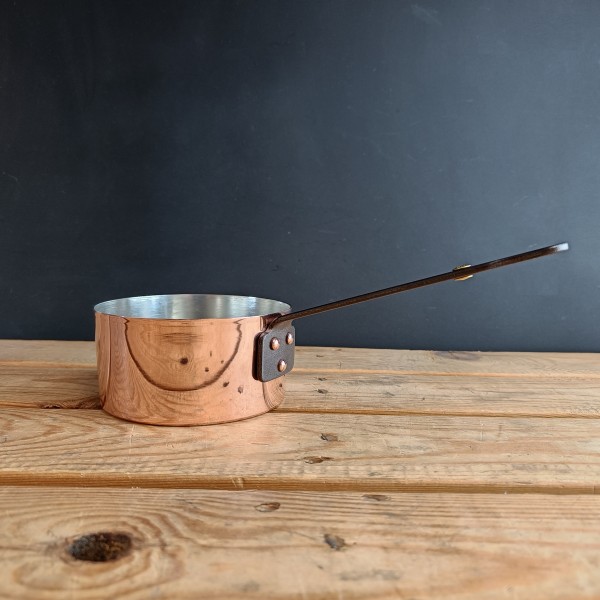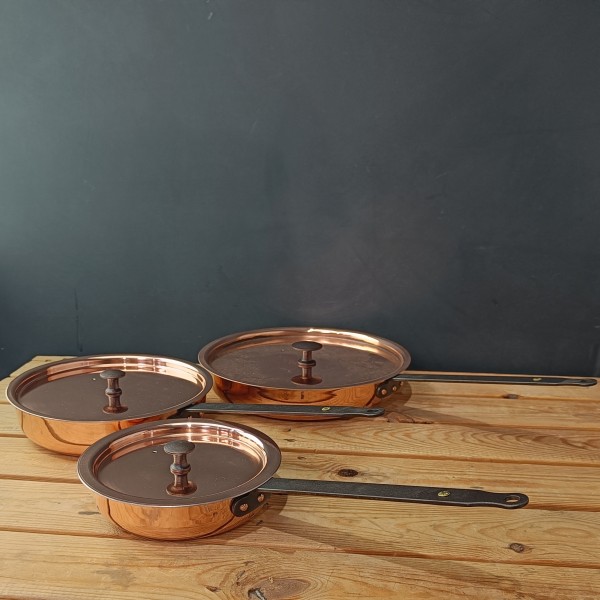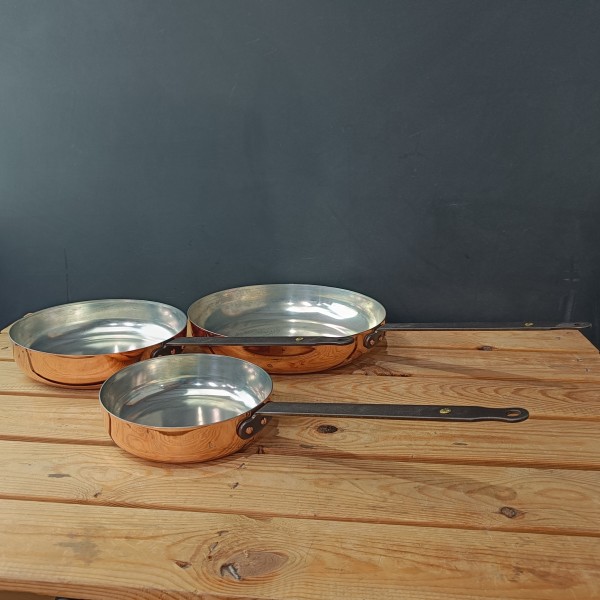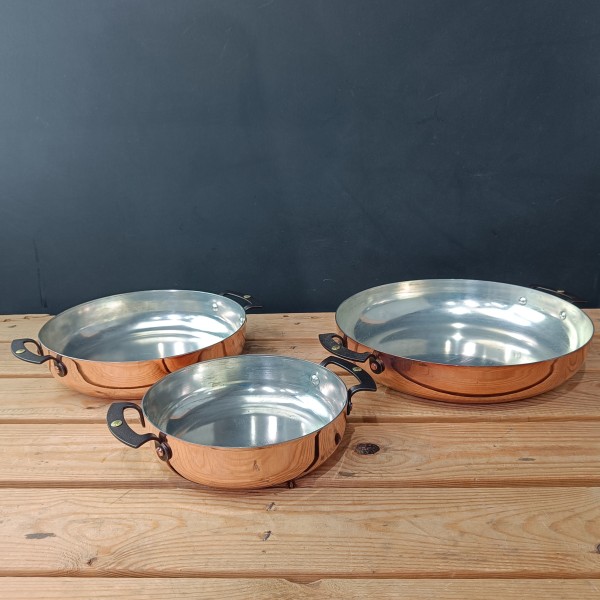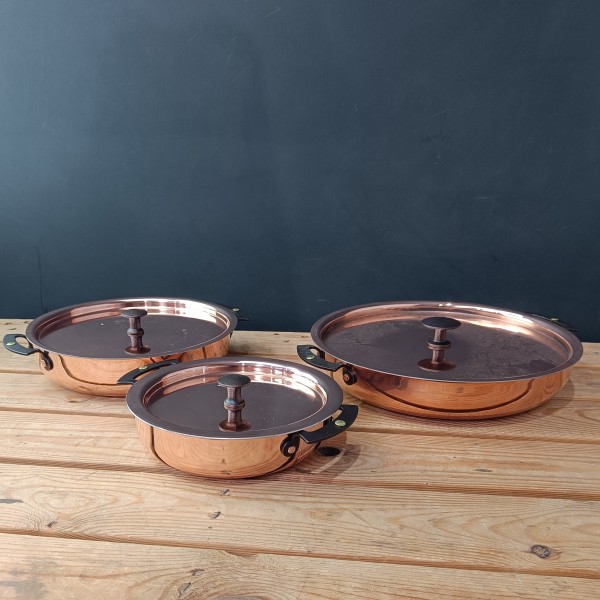Copper 10" (25.5cm) Prospector Pan FREE DELIVERY TO USA
- Brand: Netherton Foundry
- Product Code: NFS-396USA
- Availability: In Stock
-
£273.08
- Ex Tax: £227.57
Shropshire made 10’’ (25.5cm) spun copper Prospector Pan with pure tin lining ©
Tin lined copper pans have been used in the kitchens of the world's finest restaurants since the 17th century and today are still found on the stoves of discerning cooks around the world.
If you are new to tin lined copper pans we recommend that you read all of this page before buying.
Every pan is handmade, no two are the same.
Made in Britain
Double handled for easy handling and takes up less space on the hob and in the oven
Fry on the hob, brown under the grill, cook in the oven.
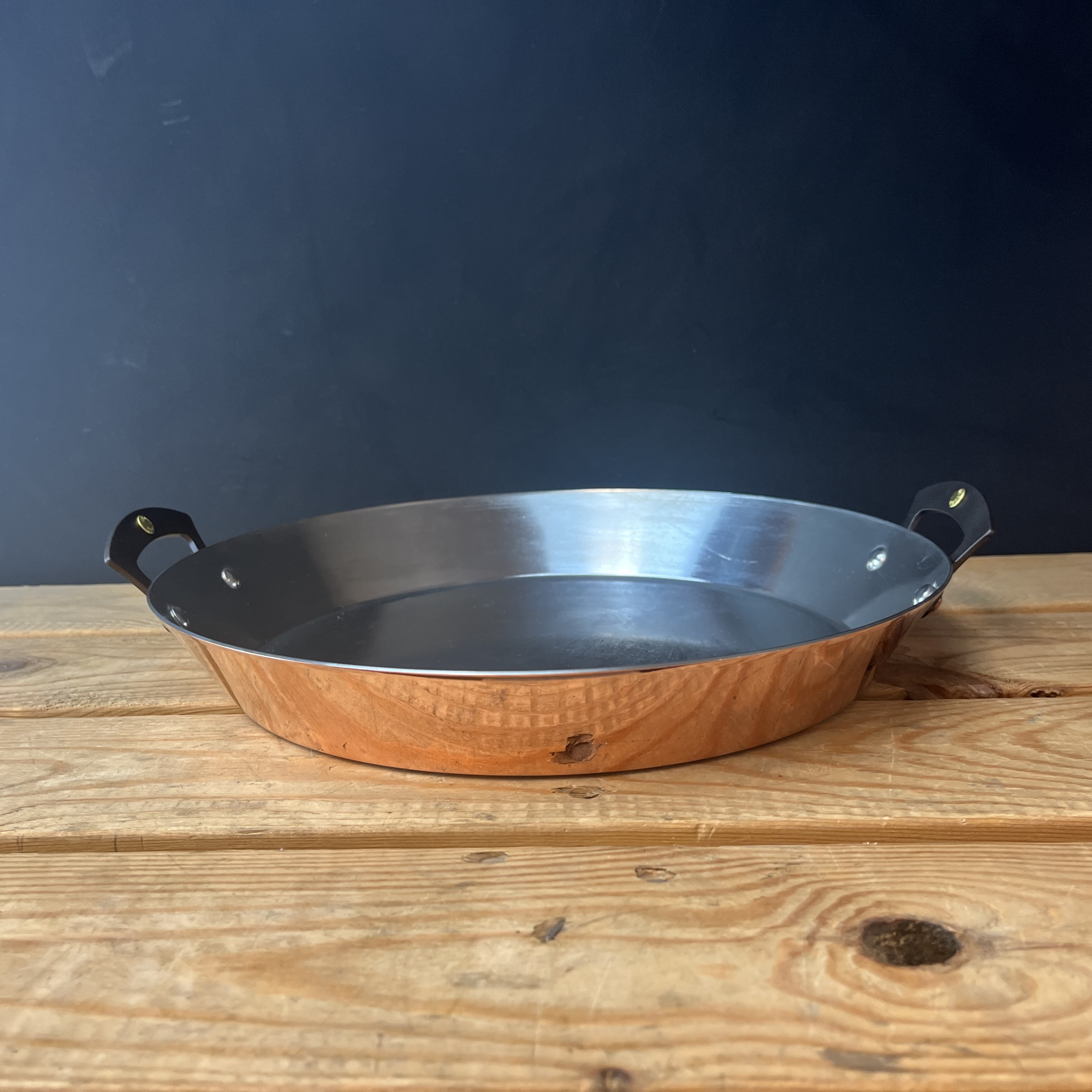
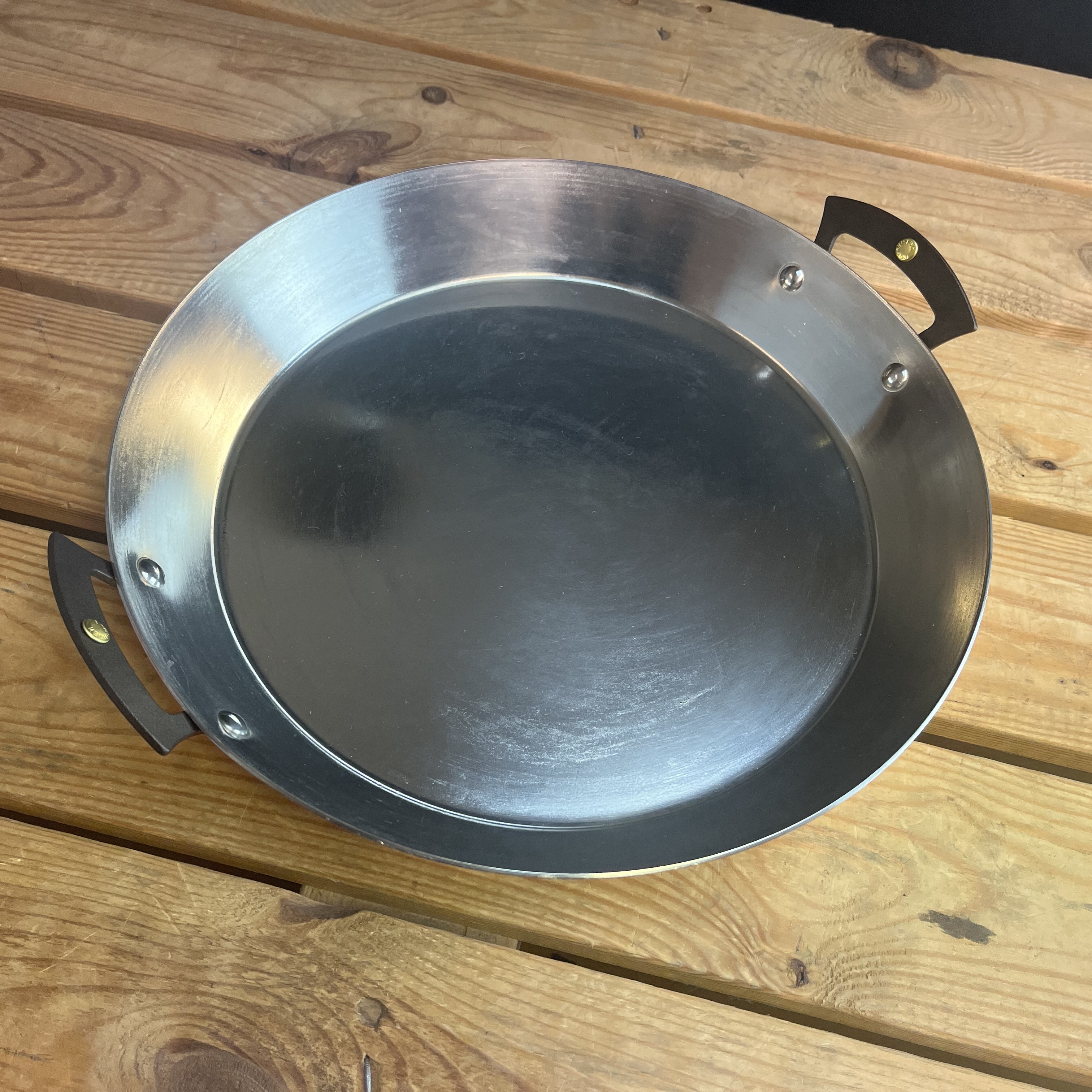
Dimensions:
Weight 0.946Kg (2lb,1oz), top rim diameter 10'' (25.5cm), base diameter 8" (20.0cm),
pan height 2" (4.5cm), base to top of handle 3" (7.5cm), width across handles 11¼" (28.5cm).
Why are tin lined copper pans so good?
It's simply physics; copper is the most conductive engineering metal available. It's twice as conductive as aluminium and an amazing 25 times more conductive than stainless steel. Possibly its only rival is pure silver, which is 5% more conductive than copper and 100 times more expensive. Our tin lining is a magical material; it is very non stick and it protects the copper from acidic food and corrosion. Tin doesn't taint food or hold strong flavours and is easily washed by hand.
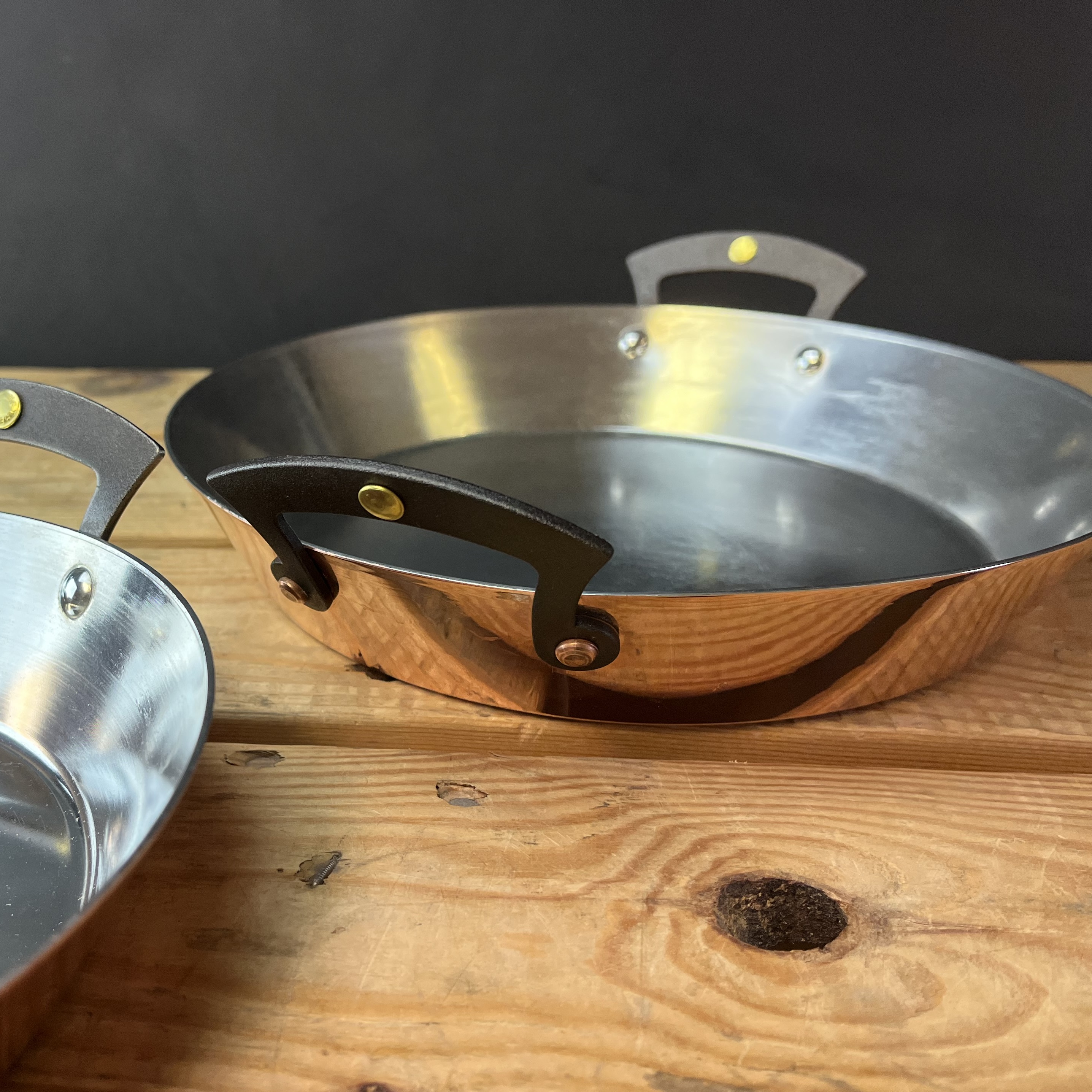
Advantages of our tin lined copper pans.
Copper is very intuitive to use, it responds quickly to changes in power.
Heat distributes very evenly across the base and sides of pan.
Pans heat up very fast and consequently use much less energy.
There is no taint from metals or coatings.
Users don't need to be concerned about the risks from chemical non-stick coatings.
The tin lining has exceptionally good non stick properties and is easy to hand wash.
Disadvantages of copper pans.
Tin melts at 232ºC (450ºF). A pan left on a high heat with no food may melt the lining that will then need retinning.
Is this a problem in real life? Not at all, for example Martha Stuart recommends cooking French Fries at 177ºC (350ºF) .
We suggest that if you wish to sear a steak at 260ºC (500ºF), then a copper pan is the wrong tool for the job. If you wish to griddle at high temperatures, we recommend using one of our spun black iron frying pans.
The tin lining will wear out rapidly if you use metal spoons and utensils, we recommend only using wood or silicon tools.
From workshop to kitchen.
During the Winter of 2022-23 Chef Stuart Collins came to Netherton Foundry and learnt how to spin and build his favourite Prospector pan.
However these were not our classic black iron models but the very first copper prospector pans!
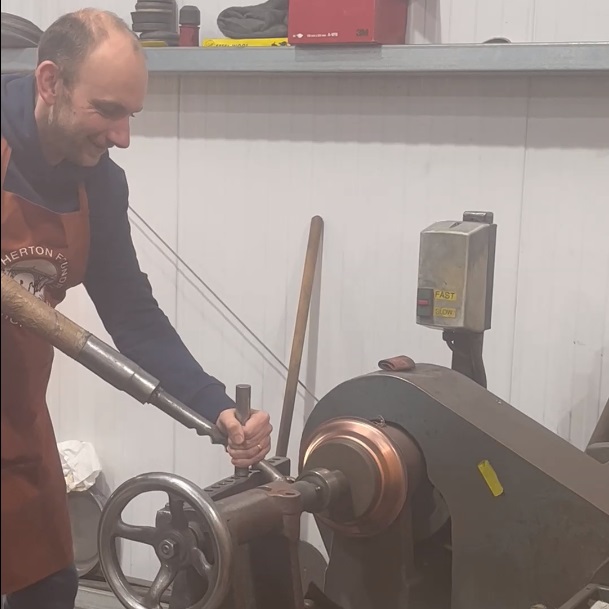
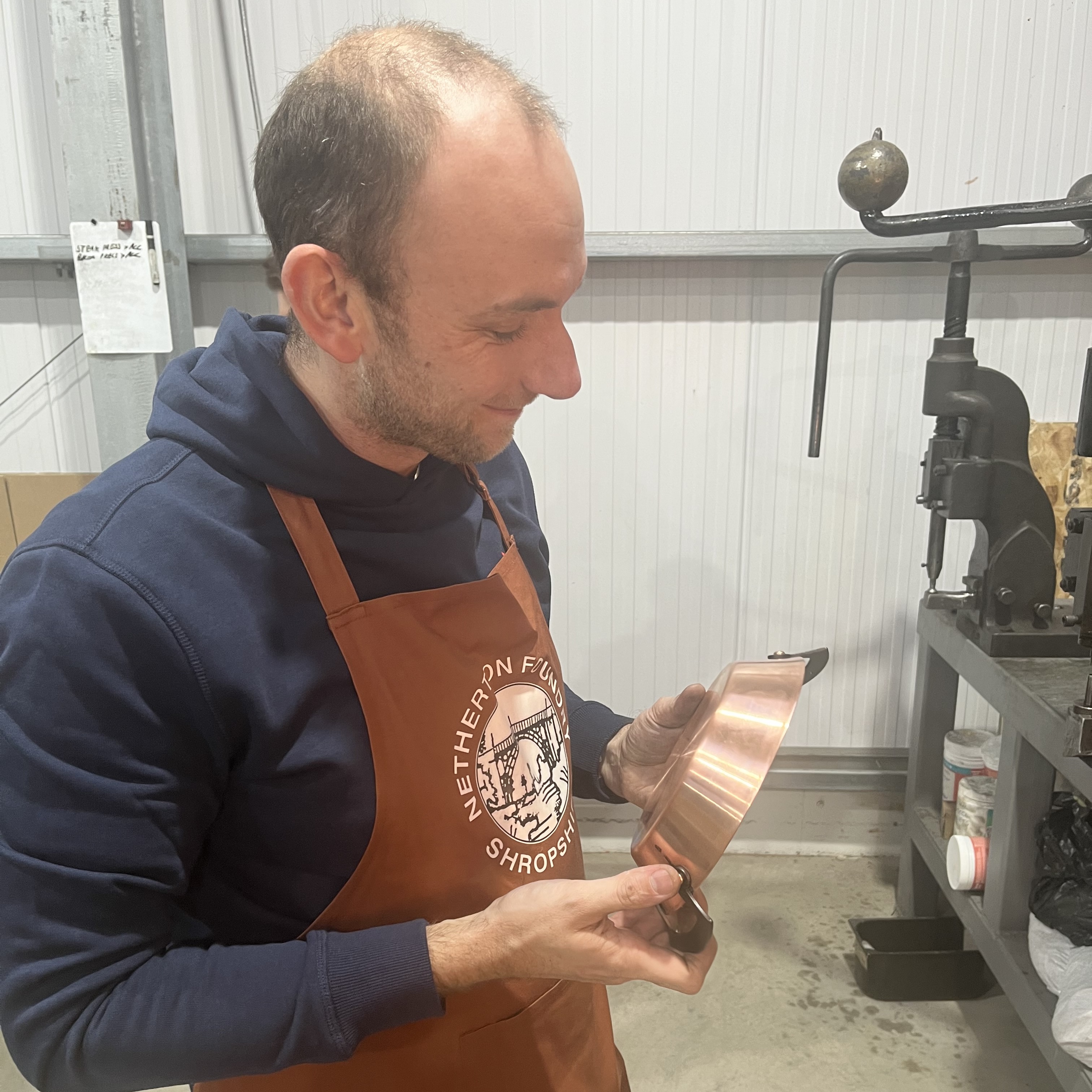
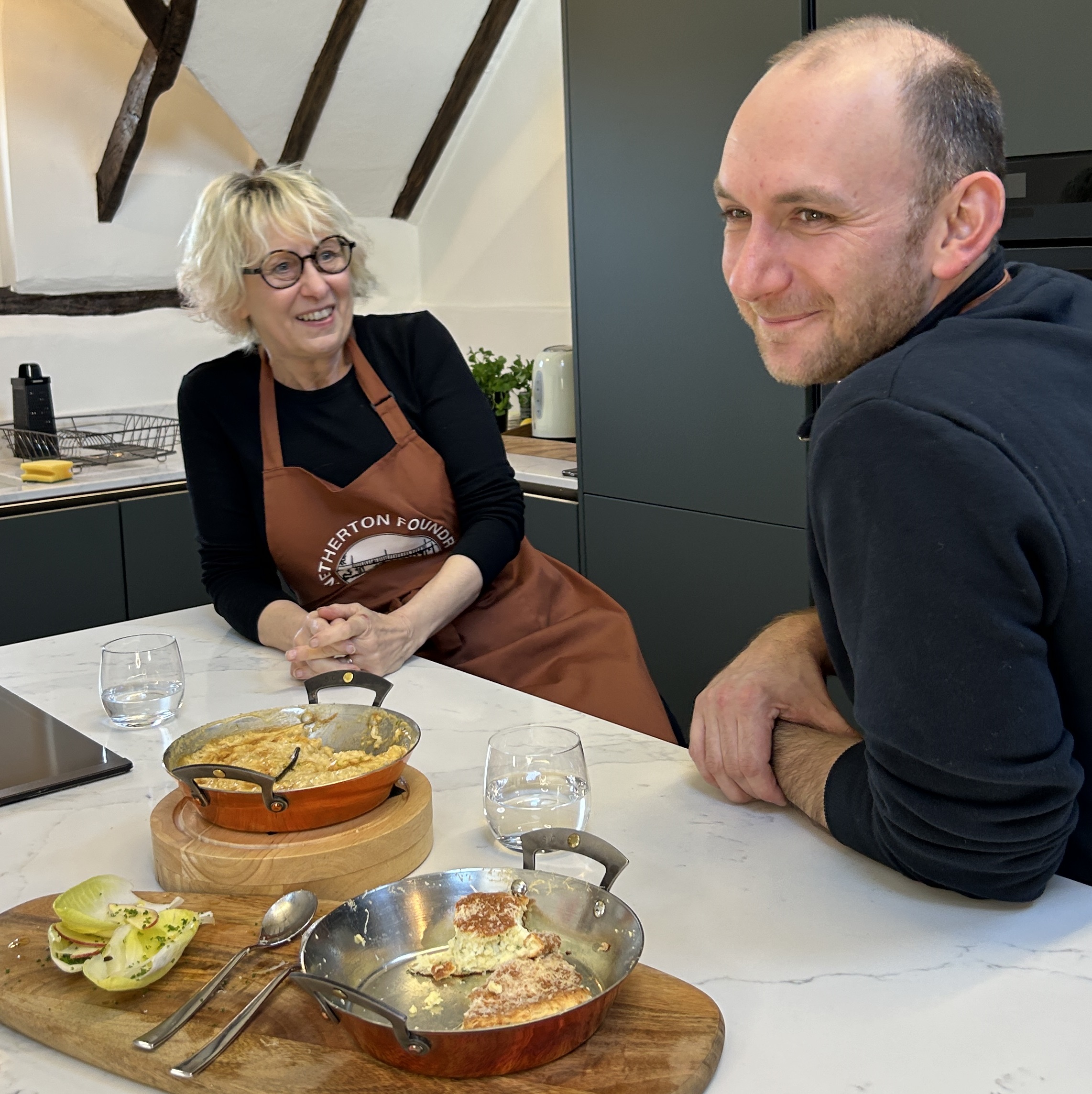
Shortly afterwards Netherton Foundry joined Stuart in his kitchen in Whitchurch, Shropshire where he taught us how to prepare four of his favourite dishes.
Stuart Collins is a Great British Menu finalist and Chef Patron of the amazing Docket 33 Restaurant in Whitchurch, Shropshire. He's an advocate of all things Salopian and that includes his Netherton Foundry pans.
In this video, Stuart shows how to prepare and cook the classic breakfast dish, Shakshuka. Onions, garlic, peppers, tomatoes, eggs fried in a Netherton Foundry 8 inch copper Prospector pan. Quick, simple, tasty and all done in 10 minutes.
This is the complete video in which we see Stuart cooking all four dishes including Shaksuka, plus we see him building his own copper Prospector pan at The Netherton workshops. Viewing time : 45 minutes.
Not all copper pans are equal.
Most copper pans sold today are in fact laminates of copper and stainless steel or even copper, aluminium and stainless steel. This does make them cheaper to buy, but does miss the principal advantage of copper. Even a thin layer of stainless steel significantly reduces the superb performance. The tin lining is simply one of the best non-stick surfaces available. In comparison, stainless steel is certainly not renowned for is non-stick qualities . So why do the famous brands choose to pass these laminates off as real copper? Simply because it's much cheaper to make and so can be sold at lower prices. This is fine if you are happy with the aesthetics and are prepared to compromise performance for a lower price. These are not real traditional copper pans. If performance is your goal, you don't want stainless steel, you need a tin lining.
Restoring and retinning old and new pans.
As new tin lined copper pans have been widely unavailable for more than 25 years, a substantial trade has developed in finding, restoring and retinning vintage pans, especially in France and the USA. We applaud this sensible reuse of materials. Inevitably the supply of quality restorable pans in sensible sets and sizes is limited and now dwindling. That's why Netherton Foundry has been encouraged by our food loving supporters once again to make new tin lined copper pans in the traditional way. If you have an old copper pan or eventually need to re-tin a Netherton pan we strongly recommend that you contact our experts: Thomas Gamesons and Sons, Stafforshire, England, They've been tin lining pans since 1818. or House Copper and Cookware, Wisconsin, USA.
The Netherton tin lined copper pans.
The hand made, solid 1.5mm, heavy duty, spun copper frying pan is polished to a soft lustre.
The hand wiped tin lining in this saucepan is food grade approved pure metal and is the classic method of protecting the copper pan from acidic foods and thus preventing flavour tainting.
This saucepan is PLASTIC, PTFE & PFOA free.
It has a durable 99.1% pure black iron pan handle fixed with three sturdy solid copper rivets. The handle is rough polished and delivered with a coating of bees wax.
Perfect for range stoves, electric, gas, ceramic and halogen hobs.
If you wish to use copper pans on induction hobs you will need a converter disc.
Copper isn't ideal for open fire cooking, for this application we recommend you look at our Spun Iron Saucepans and Sauté Pans.
Do not clean in dish washer.
Copper is a soft material, it will scratch if dragged across a rough or unclean surface. Always wipe with clean cloths or sponges.
Over heating to more than 235ºC with melt the tin lining and will distort the pan. Don't drop a hot pan into cold water.
Made in Britain.
Looking after the solid copper saucepan with traditional tin lining:
Cleaning: After use, wipe the inside and outside of the copper saucepan with soapy water and rinse thoroughly
Don’t use an aggressive scourer or you will rapidly wear through the lining and it will require re-tinning.
Temperature: Do not leave your pan on the hob unattended for too long, as if you boil it dry, the lining will melt (232º C / 450ºF), and it will require relining.
If you place your pan in an oven (some cooks seal meat on a hob, then finish in an oven), it is best not to go above 180º C / 356º F.
At home the tin lining should last for years depending on care and frequency of use. As a result we cannot guarantee the life of the lining against harsh or heavy usage
The biggest causes of rapid wear are metal spoons and whisks, so please use a wooden or silicon spoon and silicon whisk.
History of tin lined cookware.
The practice of tinning ironware to protect it against rust is an ancient one. This may have been the work of the whitesmith. This was done after the article was fabricated.
The first production of tinplate was probably in Bohemia, from where the trade spread to Saxony, and was well-established there by the 1660s when Andrew Yarranton and Ambrose Crowle, a Stourbridge blacksmith (not far from Highley, the home of Netherton) visited Dresden to find out how it was made. In Saxony the plates were forged, but when they conducted experiments on their return to England, they tried rolling the iron. This led to the ironmasters Philip Foley and Joshua Newborough erecting a new mill in 1670 in Wolverley . By 1678 they were making frying pans
Today our food grade tin is applied to a cleaned and fluxed coated pan by hand by skilled craftsmen.
A couple of handy tips:
-
If you are cooking meat or fish - oil the food, not the pan.
-
Be patient; allow the food to cook before trying to turn it over.
-
Don't fry food straight from the fridge, allow it to come up to room temperature.
The pan bodies are spun by hand, so each one is slightly different. They will not all be as flat as a billiard table.
If you do want to keep it as flat as you can, then follow these simple guidelines.
-
Every time you use the pan, heat it SLOWLY to cooking temperature. Be careful, you don't need to use full power.Use a hob the same size as the pan base, small rings WILL warp big pans.
-
Never drop a hot pan into cold water. This will buckle it.
Your pan will develop with use and if cared for, will age beautifully and be a friend for life.
INSTRUCTION BOOKLET : Caring for Netherton Foundry copper pans
Cleaning and care.
After use, leave your pan to soak in soapy water to loosen any stuck on food. Use a non-abrasive sponge or cloth and warm, soapy water to clean your pan. Rinse and dry thoroughly. Do not use an aggressive scourer, or you will rapidly wear through the lining. Never put copper pans in the dishwasher.
Netherton Foundry copper pans are lined with tin. These linings may discolour over time. This isn’t a problem. Your copper pan may need to be re-tinned at some point over its lifetime. This is only needed if you start to see copper showing through the lining.
Over time a greenish patina may develop on a copper surface. This is perfectly fine on your pan if it is not going to touch the food. If you want to remove this, the pan can be polished using a copper cleaner and a soft cloth, then rinsed with water and dried thoroughly. This should keep the copper looking shiny.
The handle is made from raw black iron & will need thoroughly drying after use or it will rust. We suggest coating the handle with a thin wipe of olive oil or bees wax to prevent rusting.
Temperature
Do not leave your pan on the hob unattended for too long; if you boil it dry, the lining will melt. The tin lining will melt at 232ºC / 450ºF.
If you place your pan in an oven, it is best not to go above 180ºC / 356ºF.
Wear & re-tinning
The tin lining is not covered by the warranty as we cannot predict wear and use. The biggest causes of rapid wear are metal spoons and whisks, so please only use wooden or silicon utensils.
If you wear through or damage the tin-lining you can get this restored by these experts.:
UK and Europe: Thomas Gameson and Sons Ltd, Staffordshire, England, they’ve been doing this for 200 years, Find out more and contact them here.
USA and Canada: Sara Dahmen at House Copper and Cookware, Wisconsin, USA : Find out more and contact her here.
We reserve the right to amend specification as part of our policy of continual product improvements. All sizes, weights, dimensions, temperatures, times, consumption figures are approximate only. Your new product has a warranty of 24 months from the date of consumer purchase. Please keep your receipt or order number as it will be required as proof of date of purchase. This warranty only applies if the item has been used solely for household use in the UK, and all instructions have been followed properly. Abuse of your product will invalidate the warranty. Returned goods cannot be accepted unless repacked properly within the original packaging and presented with the original receipt. This does not affect your statutory rights. In the event of service query, please contact us on 01746 862781 where we will be pleased to help (Monday to Thursday 9am - 4pm, Friday 9am – 2pm); or via email on sales@netherton-foundry.co.uk. You can see our full range of products, including accessories, spares and our latest recipes at: www.netherton-foundry.co.uk
Tags: Copper-pans
*please read this important information about your delivery*
You are responsible for any duty requested by the US authorities, they rarely ask for payment on shipments under $700.
Your state may expect you to pay sales tax.
If you are ordering from the USA, this page displays the price you pay in US dollars.
Prices in this section are updated daily as exchange rates vary, but you pay the price you see when you click buy.
You can change the currency from £ to $ at the top/left of this page.
When your parcel arrives, DHL may contact you to make a small charge, typically around $5 for customs clearance.
Products in this USA selection include free DHL delivery to all addresses in the contiguous USA.
Parcels shipped daily from our Shropshire workshops to the USA and typically arrive within 6 working days.
Can't find the pan you want here?
If you can't find the cookware you need in this selection or you are lucky enough to live in Hawaii or Alaska, please look at our world wide product pages,
here you will find over one hundred cast and spun black iron pans, plus traditional tinned copper cookware.
These items are all made to order and typically take two weeks to build and despatch.
Products in the world wide product pages are priced without delivery, which is calculated from your zip code during checkout. We recommend you make a separate order for these items.
Want to talk to us?
You are welcome to call us on WhatsApp on + 44 7572 385702 or email: sales@netherton-foundry.co.uk
We don't use our social media channels for sales enquires.
We work Monday to Friday ,9am to 5pm (British time) so we suggest you call us during the following times,
6am and noon Eastern time, (11am – 5pm British time) and 6am and 9am Pacific time, (2pm – 5pm British time)
Day light saving and our British summer time changes makes this complicated so you can check "Netherton Foundry" time here
19 Jan 2024










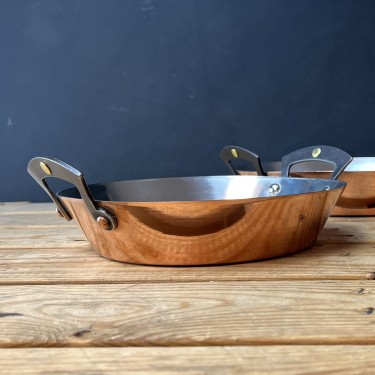
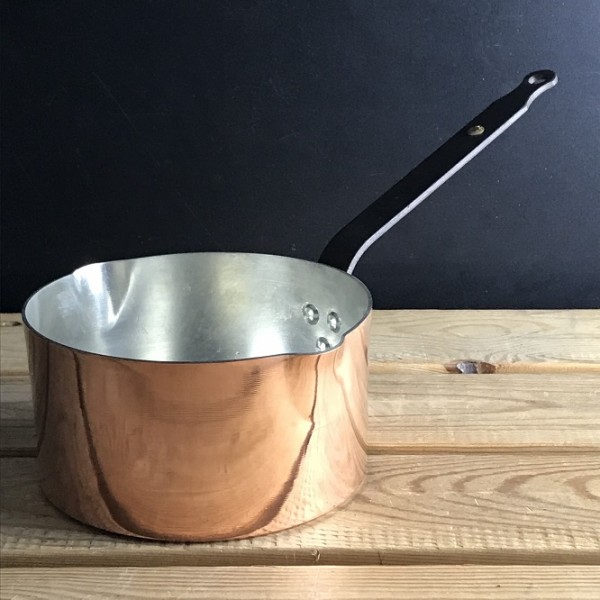
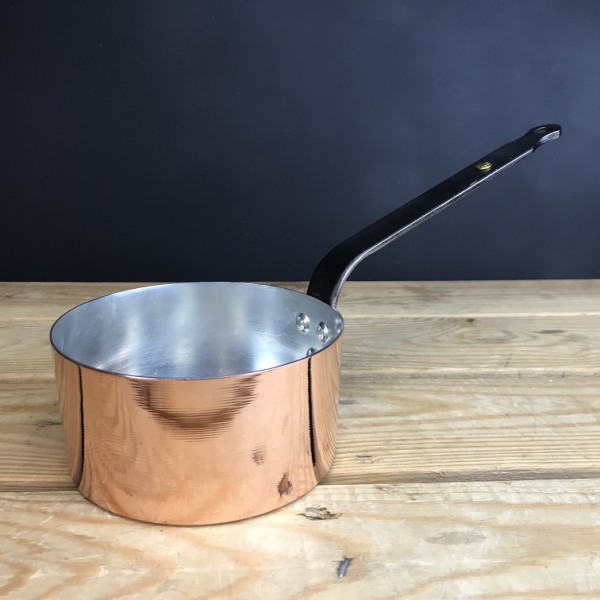
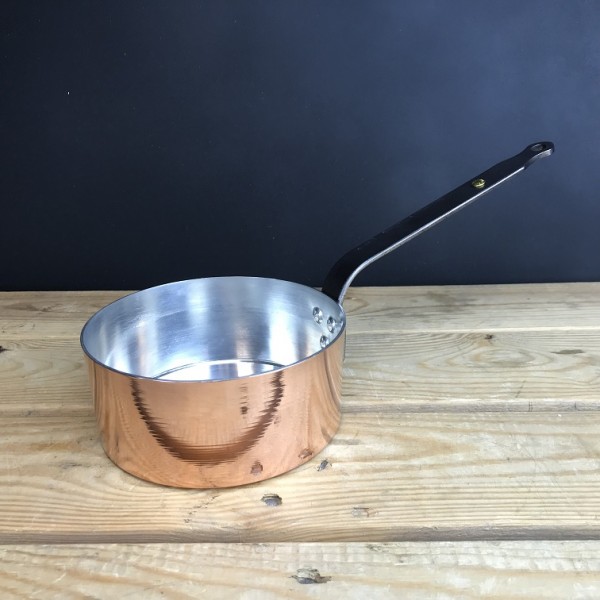
%20sml-600x600.jpg)
%20sml-600x600.jpg)
